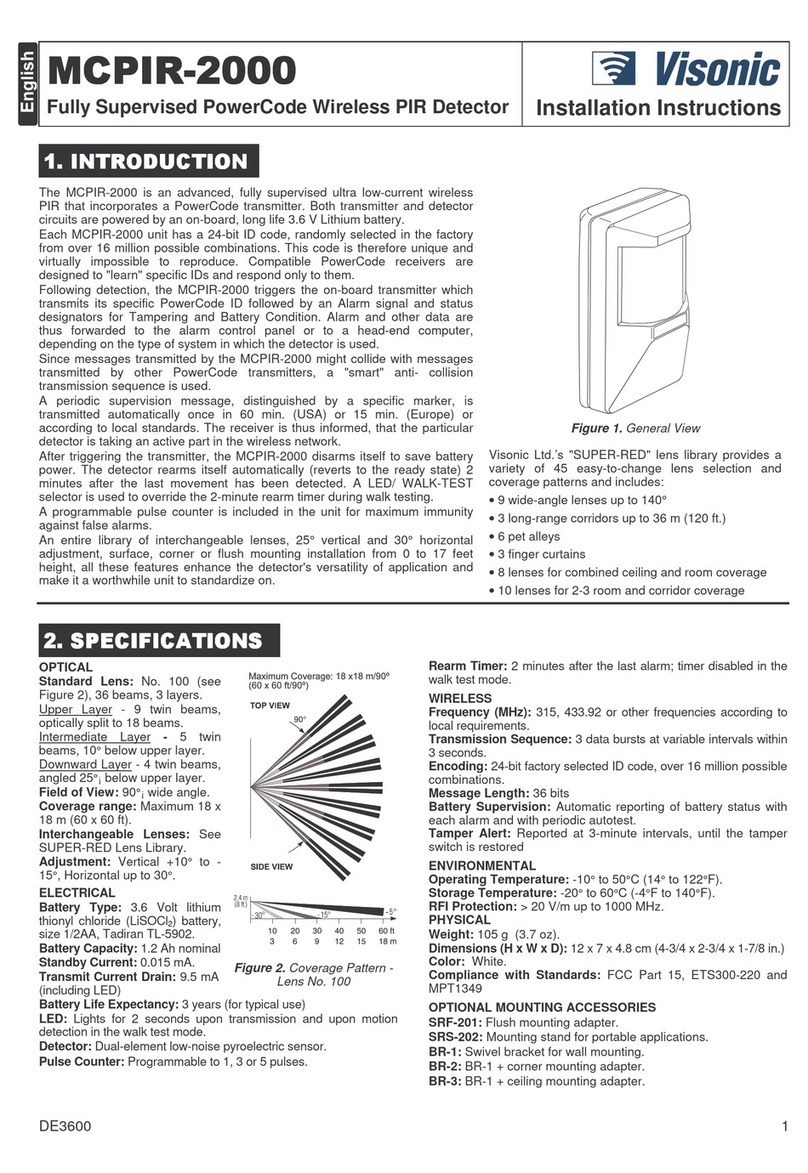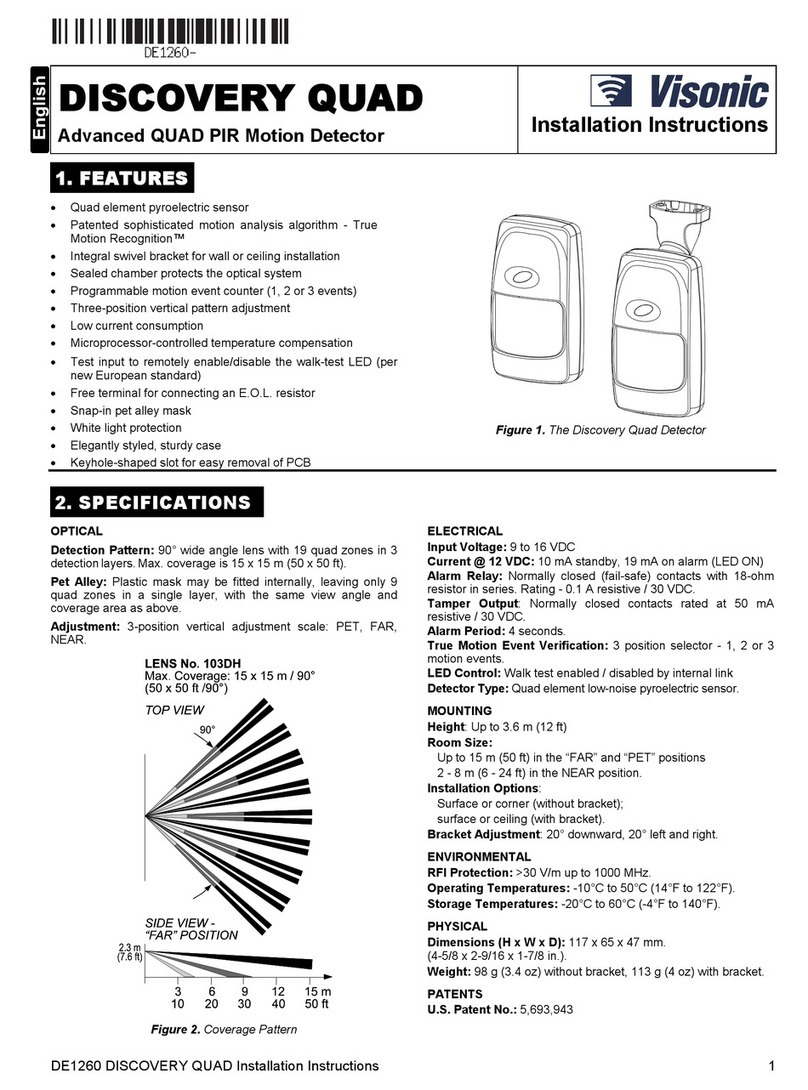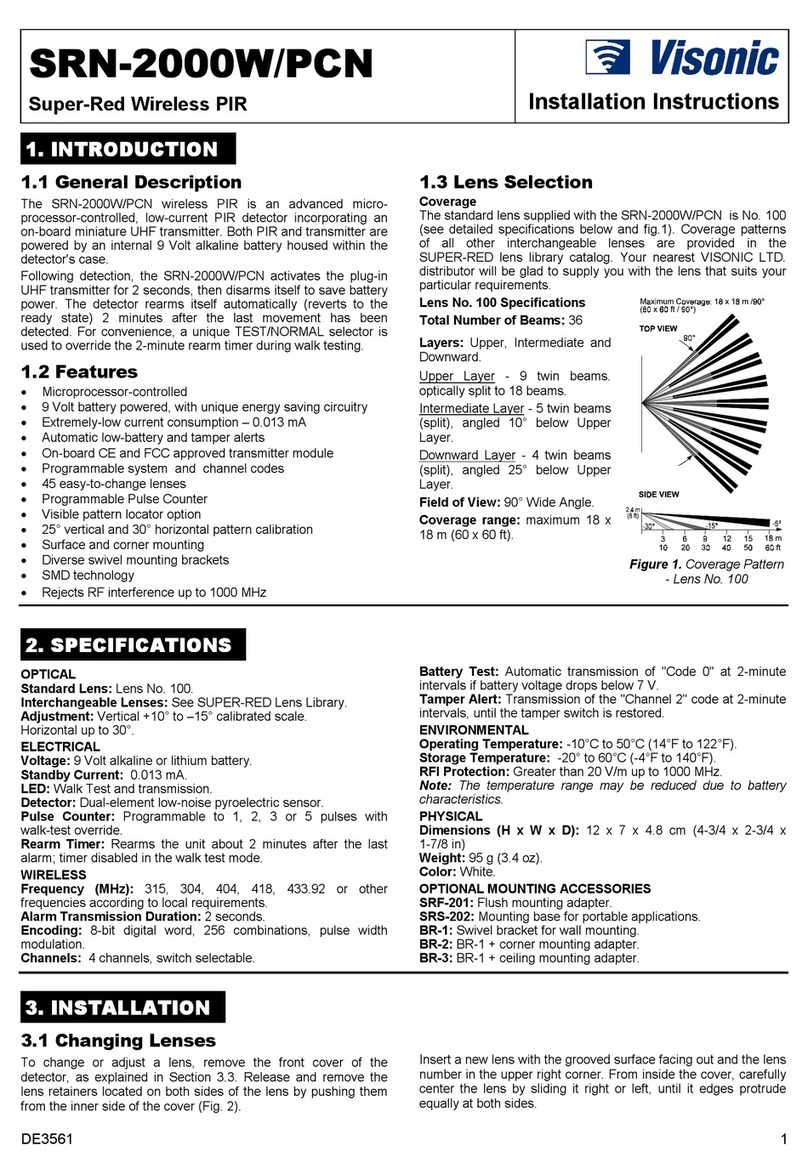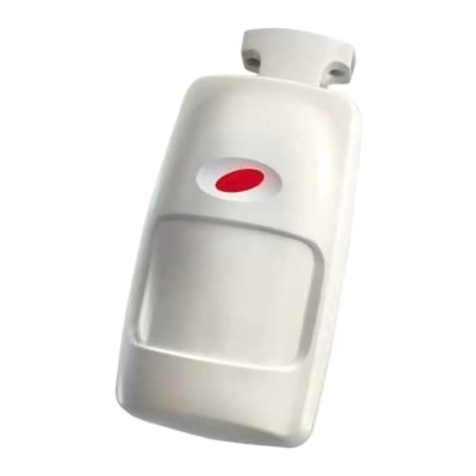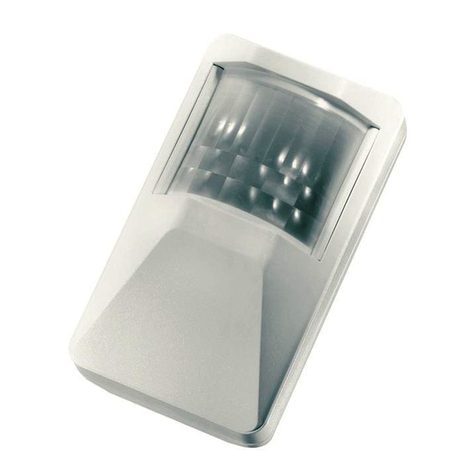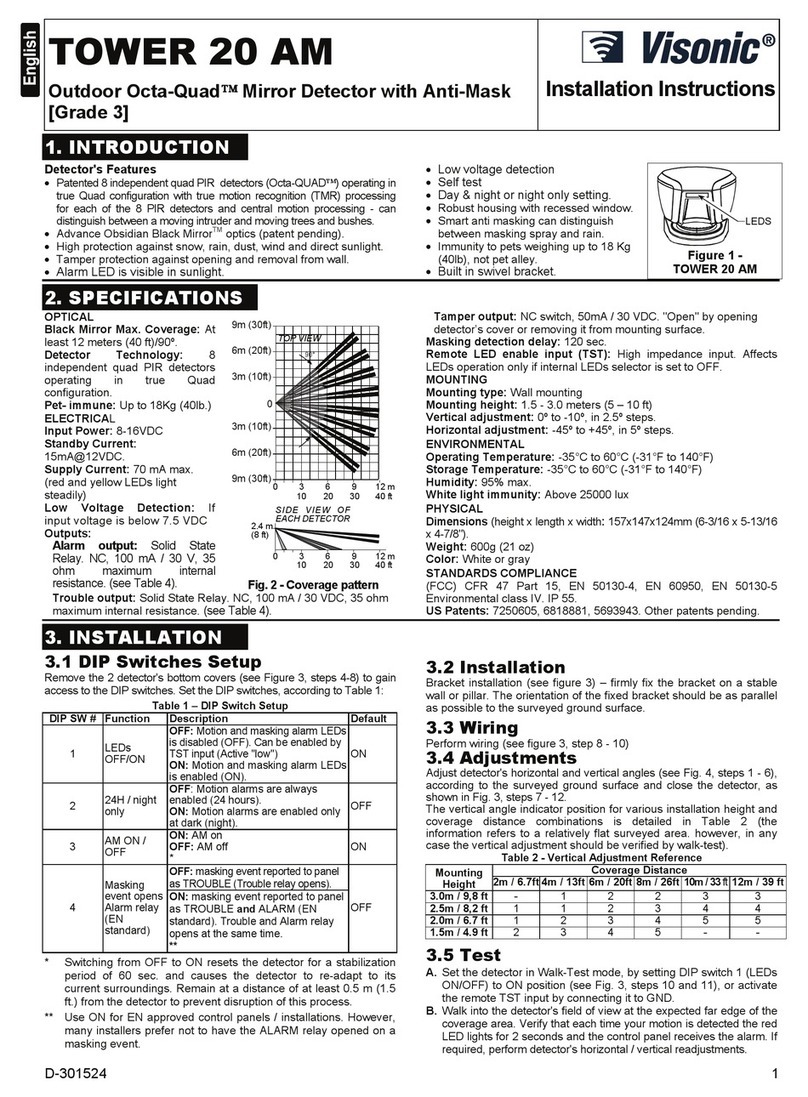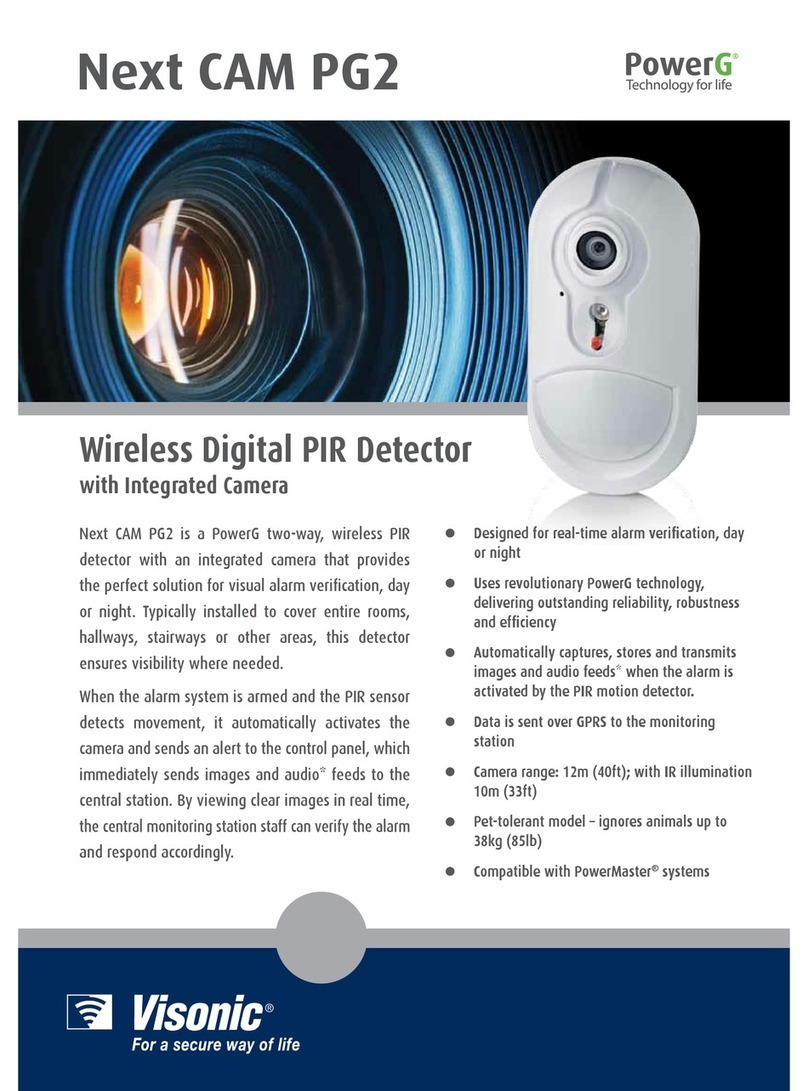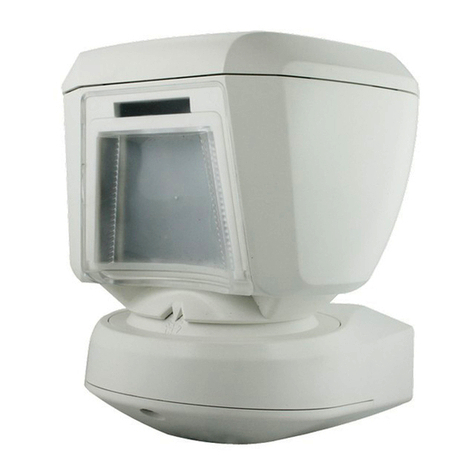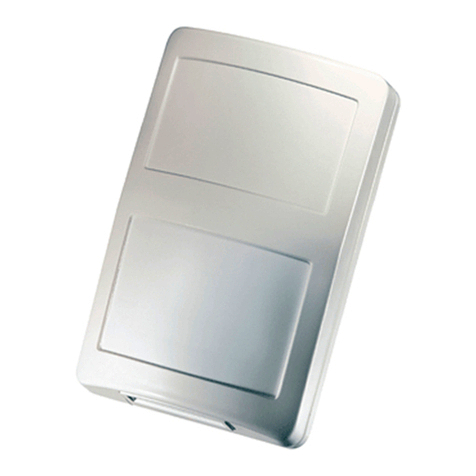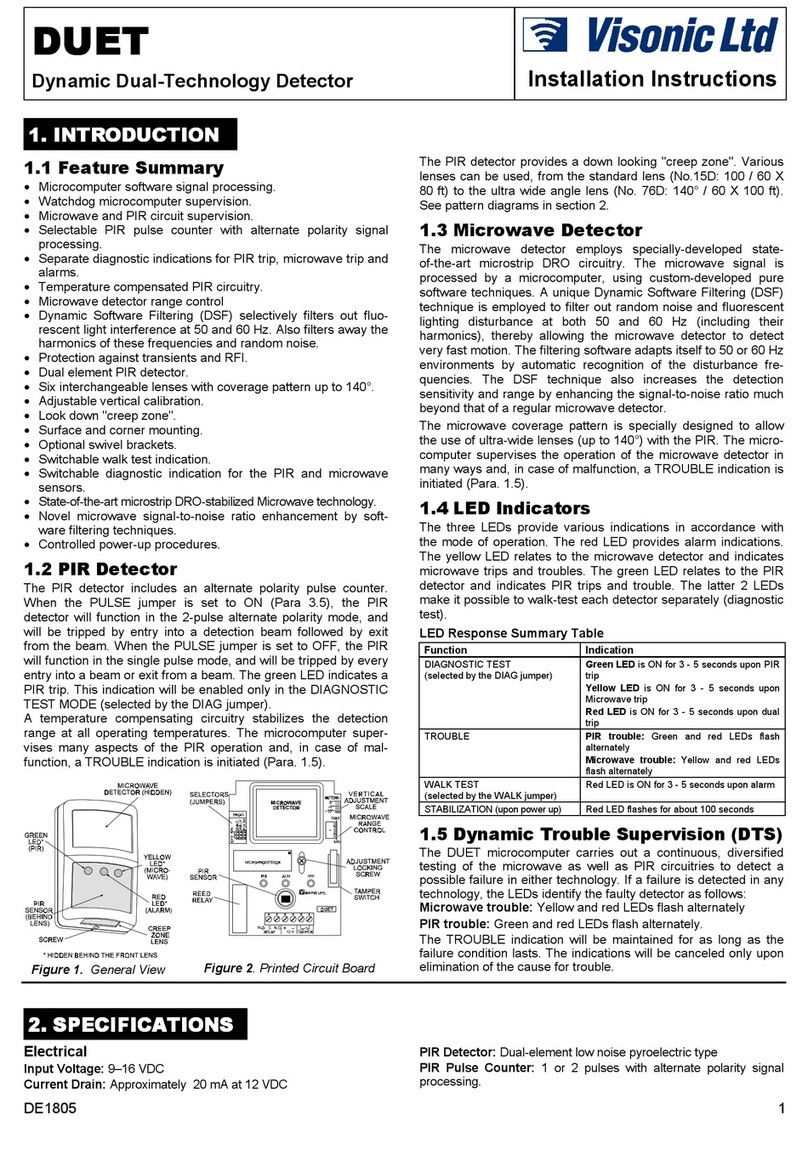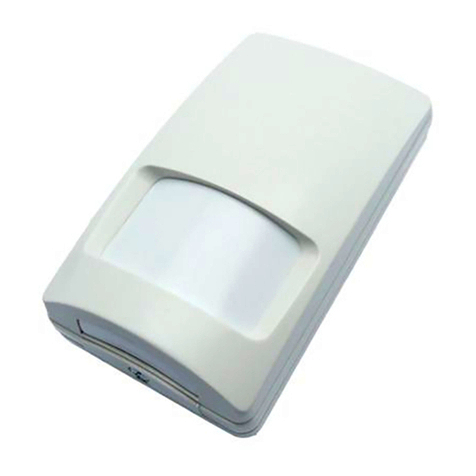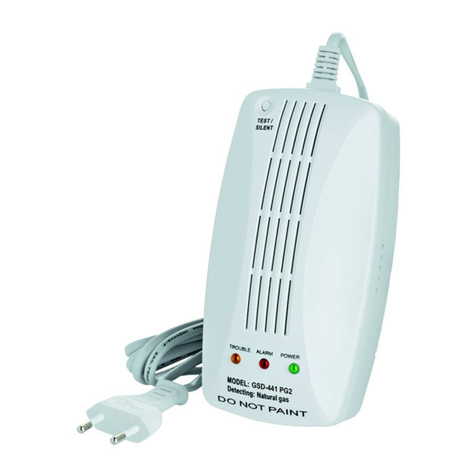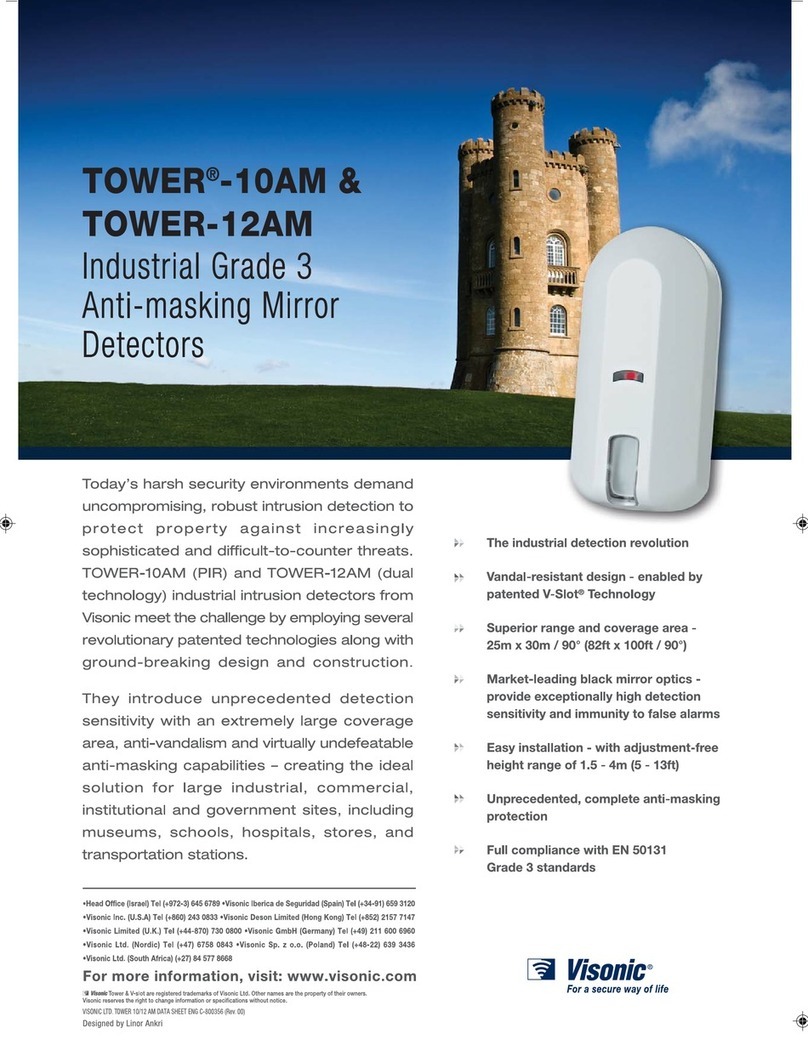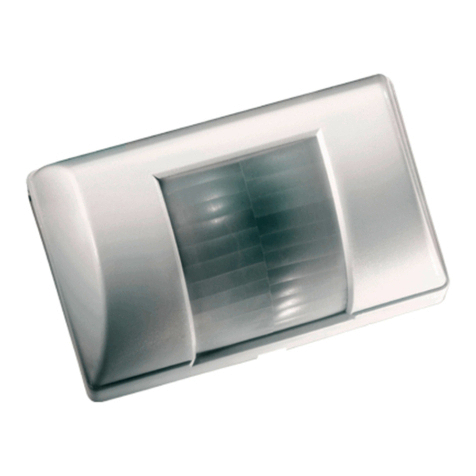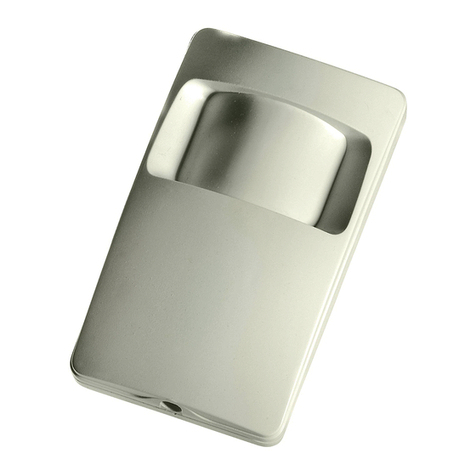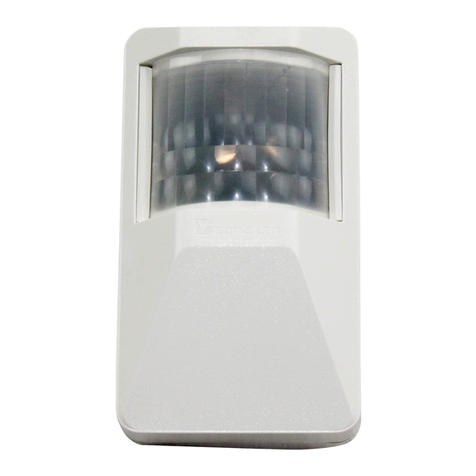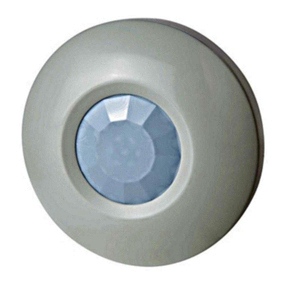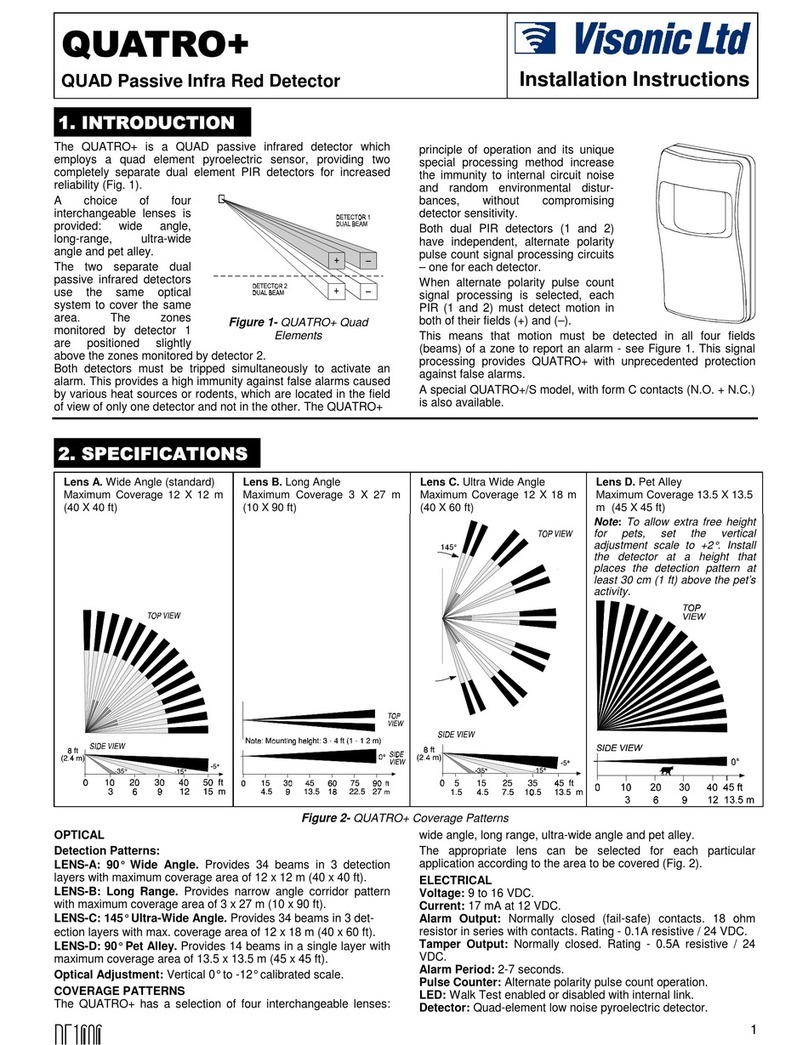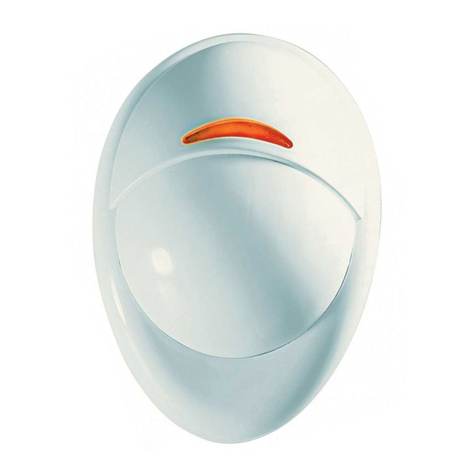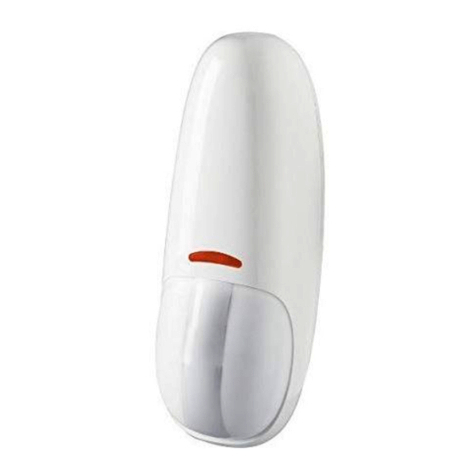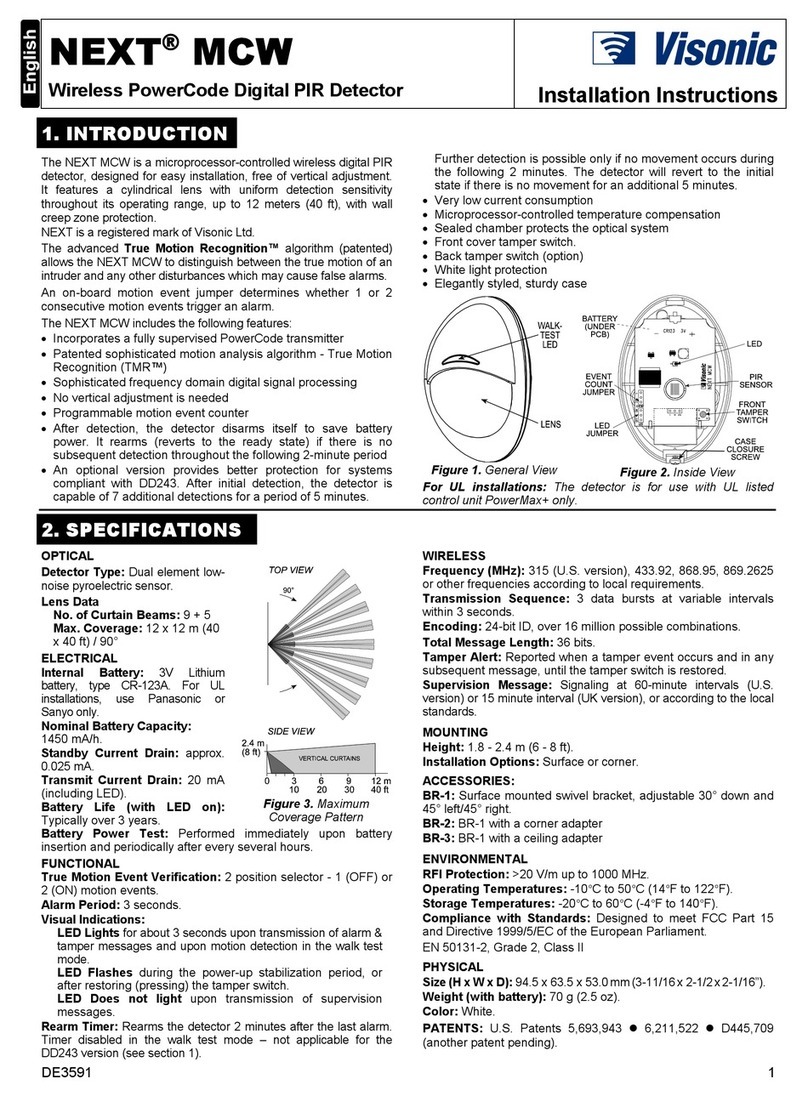4DE1141
• Slightly loosen the two locking
screws which fasten the unit to the
mounting box until the lens assembly
can be positioned up and down (with
slight friction) between the front
cover and the detector housing.
• Moving the lens assembly up or
down, set the adjusting scale to the
correct setting according to table 1
and tighten the two screws firmly.
Beam Masking Material
A special beam masking material,
supplied with each MAGIC RED sensor
can be used to mask individual
segments in the lens array which are
exposed to potential sources of false
alarm (heaters, blowers, pets etc.).
The material is transparent to visible
light but blocks infrared energy. To
block individual beam(s), locate the
corresponding segment(s) in the array.
Figure 17
-
Setting
the Vertical Adjusting
Scale
Cut the masking material to the exact dimensions of the
segment(s) to be blocked, remove the backing paper and apply
the masking material accurately to the inside (grooved) surface of
the appropriate segment(s). In some cases, more than one layer
of the lens masking material may be required to completely block
the infrared energy.
6HWWLQJWKH3XOVH&RXQWHU
Model MR-4000 is equipped with a programmable pulse counter
which can be set to count 1 or 3 pulses, before activating the
alarm relay. To set the pulse counter, place the jumper on the
desired setting (1 or 3) - see figure 16.
3 pulses: This setting provides the maximum protection against
false alarms caused by all types of environmental disturbances.
Three pulses may be selected for wide-angle, multi beam lenses
1, 4 and 5.
Note: Do not select 3-pulse operation when using lenses 2 or 3.
When the pulse counter is set to 3, no alarm will occur unless the
unit registers three pulses within approximately two minutes. This
ordinarily requires crossing more than one beam. (Each
dual-beam produces two pulses. One additional beam element is
needed to provide the third pulse).
1 Pulse This setting actually disables the pulse counter. It should
be used when it is necessary to activate an alarm on the first
detected pulse, such as with long-range lenses. One pulse
should be selected when using lenses 2 and 3, or in high security
installations when fast "catch" performance is of greatest
importance.
Self-Adjusting Walk-Test Override
The unique pulse counter incorporated in the MR-4000 features
an automatic override to single-pulse mode during walk-testing.
After alarm signaling, the pulse counter converts automatically to
single-pulse setting for several seconds. During this time period
each detection pulse will activate an immediate alarm. This
feature enables convenient walk-testing of each beam in the
coverage pattern - exactly as for a unit without a pulse counter.
Two minutes after the end of walk-testing the pulse counter
returns automatically to its original setting and is ready for a new
counting sequence.
)LQDO7HVWLQJ
A. Apply 12 VDC and allow 5 minutes for the unit’s stabilization.
B. Adjust the vertical pattern angle according to Table 1.
C. Set pulse counter per para. 3.7
D. MASK beams which face potential sources of false alarm.
E. Slowly walk-test the whole protected area across coverage
beams while observing the LED. The LED lights whenever
you enter or exit coverage beam. Allow 5 minutes interval
between tests for unit’s settling down.
F. Check the operation of the alarm relay and the tamper switch.
Warning: After walk testing disable the LED by setting the
LED selector to OFF position.
Important: Whenever you open and close the detector,
make sure that the scale is adjusted to the correct setting
and that the locking screws are firmly tightened, so that the
position of the lens housing cannot be changed.
0DLQWHQDQFH
Proper operation, range and coverage pattern should be checked
at least once a week according to para. 3.8. To assure proper
continuous operation, the end user should be instructed to walk
through the entire coverage pattern and to assure an alarm
output, each time, before the alarm system is armed.
:$55$17<
:$55$17<
Visonic Ltd. and/or its subsidiaries and its affiliates ("the Manufacturer") warrants its
products hereinafter referred to as "the Product" or "Products" to be in conformance with
its own plans and specifications and to be free of defects in materials and workmanship
under normal use and service for a period of twelve months from the date of shipment by
the Manufacturer. The Manufacturer's obligations shall be limited within the warranty
period, at its option, to repair or replace the product or any part thereof. The Manufacturer
shall not be responsible for dismantling and/or reinstallation charges. To exercise the
warranty the product must be returned to the Manufacturer freight prepaid and insured.
This warranty does not apply in the following cases: improper installation, misuse,
failure to follow installation and operating instructions, alteration, abuse, accident or
tampering, and repair by anyone other than the Manufacturer.
This warranty is exclusive and expressly in lieu of all other warranties, obligations or
liabilities, whether written, oral, express or implied, including any warranty of
merchantability or fitness for a particular purpose, or otherwise. In no case shall the
Manufacturer be liable to anyone for any consequential or incidental damages for breach
of this warranty or any other warranties whatsoever, as aforesaid.
This warranty shall not be modified, varied or extended, and the Manufacturer does not
authorize any person to act on its behalf in the modification, variation or extension of this
warranty. This warranty shall apply to the Product only. All products, accessories or
attachments of others used in conjunction with the Product, including batteries, shall be
covered solely by their own warranty, if any. The Manufacturer shall not be liable for any
damage or loss whatsoever, whether directly, indirectly, incidentally, consequentially or
otherwise, caused by the malfunction of the Product due to products, accessories, or
attachments of others, including batteries, used in conjunction with the Products.
The Manufacturer does not represent that its Product may not be compromised and/or
circumvented, or that the Product will prevent any death, personal and/or bodily injury
and/or damage to property resulting from burglary, robbery, fire or otherwise, or that the
Product will in all cases provide adequate warning or protection. User understands that a
properly installed and maintained alarm may only reduce the risk of events such as
burglary, robbery, and fire without warning, but it is not insurance or a guarantee that such
will not occur or that there will be no death, personal damage and/or damage to property
as a result.
The Manufacturer shall have no liability for any death, personal and/or bodily injury
and/or damage to property or other loss whether direct, indirect, incidental,
consequential or otherwise, based on a claim that the Product failed to function.
However, if the Manufacturer is held liable, whether directly or indirectly, for any loss or
damage arising under this limited warranty or otherwise, regardless of cause or origin, the
Manufacturer's maximum liability shall not in any case exceed the purchase price of the
Product, which shall be fixed as liquidated damages and not as a penalty, and shall be the
complete and exclusive remedy against the Manufacturer.
Warning: The user should follow the installation and operation instructions and among
other things test the Product and the whole system at least once a week. For various
reasons, including, but not limited to, changes in environmental conditions, electric or
electronic disruptions and tampering, the Product may not perform as expected. The user
is advised to take all necessary precautions for his /her safety and the protection of
his/her property. 6/91
VISONIC LTD (ISRAEL): P.O.B 22020 TEL-AVIV 61220 ISRAEL. PHONE: (972-3) 645-6789, FAX: (972-3) 645-6788
VISONIC INC. (U.S.A.): 10 NORTHWOOD DRIVE, BLOOMFIELD CT. 06002-1911. PHONE: (860) 243-0833, (800) 223-0020 FAX: (860) 242-8094
VISONIC LTD. (UK): UNIT 1, STRATTON PARK, DUNTON LANE BIGGLESWADE, BEDS. SG18 8QS. PHONE: (01767) 600857 FAX: (01767) 601098
VISONIC LTD. 1998 MR-4000 D-1141-0 NEW: DE1141- (REV. 1, 6/98)

